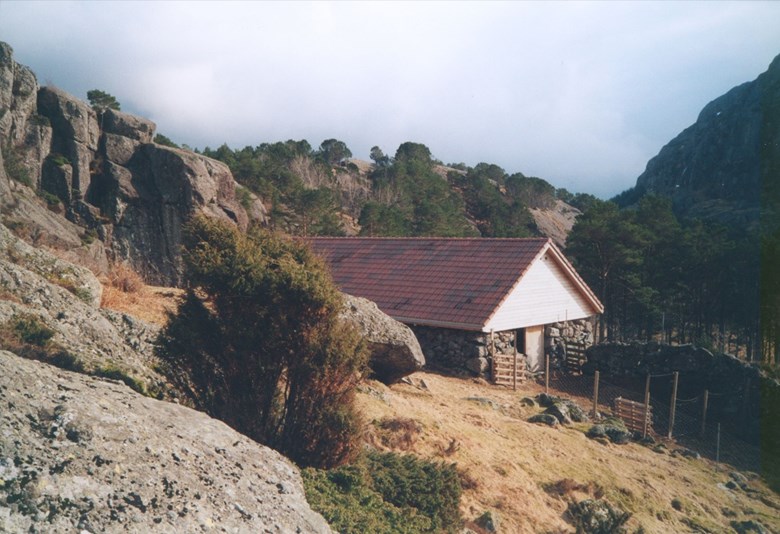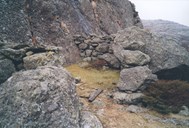The wild sheep was light-footed
Sheep farming was common and was considered a useful food supplement in the many-sided commodities on the small farm of the islanders. Solund had numerous islands and islets for the wild sheep, which especially in summer were left to themselves on a limited area of pasture. But it was the harder to catch them when the owner wanted to move them or take them home. Some sheep were tame, then as now, but on the whole the wild sheep were quite light-footed and fast. On the islets there was pasture for only a few animals, and they could as a rule be chased along a cliff, or, as they did at Gåsvær with a twinkle in their eyes, catch them with the remnants of a salmon seine.

"Kvia"(cote) and "Rekjet" (stonewall) common place names
On the larger islands, there were since times immemorial stone walls to make sheepfolds, or "kviar" , as they called them. They were maintained and improved in step with their usefulness and interest. By making stone fences leading into the sheepfold itself, they needed fewer children to help in the collection of the sheep. When the crag was on the one side and the sea on the other, the situation was under control. When the sheep arrived at the sheepfold, most of them were disillusioned and indifferent. The lambs, however, made a lot of noise until contact was re-established. Frisky, castrated animals tested their limits by climbing and making high jumps, and found their places as high up as possible. They even jumped into the deep sea if they saw their freedom there.
On paper sacks and tarpaulin
The size of the sheepfold corresponded to some extent with the number of animals. Where several farms collected together, the enclosure and the place around it had to be reasonably spacious. Women and men sat on the ground on paper sacks or tarpaulin with their shears working. There had to be room for the bags with wool, one or more for each family member. Bell collars would be repaired or changed if necessary. The sheep which was fastest into the high ground, would lose the bell. Pretty, small lambs were cut in their ears, no matter how long the children patted them, cried, and begged. The treatment of the ram lambs took place in more secrecy.
Wet wool unsuitable
If rain started this meant bad luck. Drying the wool was a time-consuming process, even in sunshine. If it kept on raining, the wool would occupy boat stems, and hay-drying poles would blockade boathouses and barns for weeks. More fortunate were those who owned big caves and part of the sheepfold was under the stone. Some built roofs over the stone fences, so that the sheep were dry at least while they waited their turn. The stay on the bag, with a brown silk stocking tightly fastened round three legs, lasted only a few many minutes. Teenagers in training wisely chose patient animals, and preferred animals which were beginning to lose their wool. They were easy work, they said.

Sheepfolds partly out of use
The branding took place before the haymaking, but the sheepfold was used more often than that. In late summer the lambs were separated, near Christmas the sheep ready for slaughter were picked. If calves happened to have become shy and needed renewal of the contact with the people on the farm, the sheepfold was a good place to fall back on.
As time went on, people started to keep indoor sheep. They were tame and could be called for like dogs. The shearing was done at a different season. Some of the sheepfolds were not used. But if a stone falls, if bushes and scrubs stretch out from the sheepfold floor, there is perhaps a rusty bell collar in the stone fence, reminding us of former activities.



